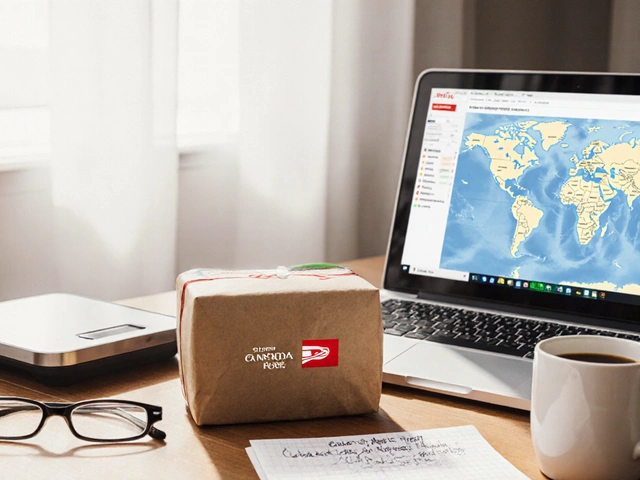Logistics Earnings Calculator
People ask if you can make good money in logistics-and the answer isn’t a simple yes or no. It depends on where you are, what you’re doing, and how much you’re willing to put in. In 2025, logistics isn’t just trucks and warehouses anymore. It’s data, automation, global networks, and smart decision-making. And for those who know how to play the game, it pays well.
How logistics companies actually make money
Logistics companies don’t earn by moving boxes. They earn by reducing friction. The biggest profit drivers aren’t fuel surcharges or delivery fees-they’re efficiency, scale, and control. A company that can consolidate 500 shipments into one truckload saves thousands in fuel and labor. That’s where the real margin lives.
Take a regional freight carrier in Ontario. They might charge $120 to move a pallet from Toronto to Ottawa. But if they fill 12 pallets per trip, use route optimization software, and keep their drivers on schedule 95% of the time, their net profit per trip can hit $450. Multiply that by 20 trips a week, and you’re looking at $46,800 a month before taxes. That’s not luck. That’s operations.
Big players like DHL or FedEx make money through volume and contracts. But the real money today is in niche segments: cold chain logistics for pharmaceuticals, same-day delivery for urban e-commerce, or specialized transport for industrial equipment. These aren’t commodity services. They’re high-margin, hard-to-replicate offerings.
What roles pay the most in logistics
If you’re thinking of working in logistics, not all jobs are equal. A warehouse picker might earn $22 an hour in Toronto. A logistics coordinator? Maybe $28. But here’s where the pay jumps:
- Logistics Manager: $85,000-$120,000/year. You’re responsible for entire regional networks, vendor contracts, and cost control.
- Supply Chain Analyst: $75,000-$105,000. You use data to cut costs-predicting delays, rerouting shipments, negotiating with carriers.
- Freight Broker Owner: $100,000-$500,000+/year. No employees? No problem. You connect shippers with carriers and take a cut. Top brokers in Canada handle $10M+ in monthly freight volume.
- Owner of a Small Trucking Company: $150,000-$400,000/year. Buy one truck, get contracts, hire drivers as contractors. Keep overhead low, and profit margins can hit 20-30%.
One person I know in Hamilton runs a two-truck operation. He doesn’t own a warehouse. He doesn’t have a sales team. He just uses Loadsmart and uShip to find backhaul loads. His net profit last year? $218,000. He works 50 hours a week. Not bad for a guy who started with a used 2015 Freightliner.
The hidden costs that eat your profits
Anyone who tells you logistics is easy money is lying. The biggest killers are:
- Truck maintenance: A single breakdown can cost $5,000 in repairs and lost time. Diesel engines don’t lie-you pay for every mile.
- Insurance: Commercial liability insurance for a 18-wheeler in Canada averages $12,000-$18,000 a year. Add cargo insurance? That’s another $3,000-$8,000.
- Driver turnover: If you lose a driver every 6 months, you’re spending $10,000+ per hire on training, background checks, and lost productivity.
- Fuel volatility: Diesel prices in Ontario swung from $1.45/L to $1.95/L in 2024. That’s a 34% cost jump on a single run.
Successful operators don’t just chase loads. They build buffers. They lock in fuel prices with futures contracts. They keep a spare engine on hand. They train drivers to spot early signs of wear. Profit isn’t about how many loads you haul-it’s about how few mistakes you make.

Can you start with nothing?
Yes-but not with a truck. The lowest-barrier entry is freight brokering. You don’t need a license to start. You don’t need a warehouse. You need:
- A phone and a computer
- A free account on a load board like DAT or Truckstop.com
- A way to find shippers who need to move goods
- A network of owner-operators willing to haul for you
You charge the shipper $1,200 to move a load. You pay the driver $900. You keep $300. That’s your profit. Do 10 loads a week? That’s $12,000 a month. Do 30? You’re at $36,000. And you don’t own a single vehicle.
It’s not glamorous. You’re on the phone all day. You’re chasing payments. You’re dealing with angry shippers when a truck breaks down. But the barrier to entry is near zero. And the upside? Unlimited.
What’s changing in 2025
Logistics is being rewritten by tech. AI now predicts delivery delays with 89% accuracy. Autonomous trucks are being tested on Highway 401. Drones are delivering medical supplies in rural Ontario. If you’re still using paper waybills and Excel sheets, you’re falling behind.
Companies that are winning are investing in:
- Route optimization software (like OptimoRoute or Upper) that cuts fuel use by 15-25%
- Real-time tracking that lets customers see their package at every stop
- Automation in warehouses-robots that sort packages 3x faster than humans
- Carbon tracking-shippers now demand emissions reports. Green logistics isn’t optional anymore.
These tools cost money. But they pay for themselves. A small fleet that adopts route software can save $18,000 a year in fuel alone. That’s a 15% profit boost on a $120,000 revenue business.

Who should avoid logistics
Logistics isn’t for everyone. Don’t jump in if:
- You hate unpredictable hours. Deliveries don’t stop at 5 p.m.
- You can’t handle stress. A missed delivery can cost you a client for life.
- You expect quick riches. It takes 18-24 months to build a profitable operation.
- You’re bad with numbers. One misplaced decimal in a quote can wipe out your profit.
And if you think you can just buy a truck and start making money? You’ll be one of the 70% of new owner-operators who quit within two years.
Bottom line: Yes, you can make good money-but it’s not easy
Logistics is one of the few industries where hard work, smart systems, and discipline still pay off. You won’t get rich overnight. But if you’re willing to learn the systems, control the costs, and serve customers well, the money is there.
The best earners aren’t the ones with the biggest fleets. They’re the ones who know their numbers, adapt fast, and never stop improving. In 2025, logistics rewards those who treat it like a business-not a job.
Can you make $100,000 a year in logistics without owning a truck?
Yes. Freight brokers, logistics coordinators, and supply chain analysts regularly hit six figures without owning a single vehicle. A broker handling 20-30 loads a week at $300 profit per load makes $72,000-$108,000 a year. Add commissions, contracts, and volume, and $100,000+ is realistic with consistent effort.
What’s the easiest way to start in logistics with little money?
Start as a freight broker. Use free load boards like DAT or Truckstop.com to connect shippers with owner-operators. You don’t need a license to begin. Invest in a good phone, a laptop, and time. Learn how to negotiate rates and manage contracts. Within 6-12 months, you can build a steady income stream without any upfront vehicle costs.
Is logistics a good career for someone in their 40s or 50s?
Absolutely. Logistics values experience. A 50-year-old with a background in operations, sales, or management can easily transition into logistics coordination, dispatch, or even freight brokering. Many successful owner-operators start in their 40s after leaving corporate jobs. The industry doesn’t care about your age-it cares about reliability and results.
How much does it cost to start a small trucking company in Canada?
You can start with one used truck for $60,000-$90,000. Add $10,000-$15,000 for insurance, permits, and registration. Software and accounting tools cost another $500-$1,000 a year. Total startup cost: $75,000-$110,000. Many start by leasing a truck or partnering with an existing carrier to reduce upfront costs.
Are logistics jobs safe from automation?
Some roles are being automated-warehouse picking, basic dispatching, and route planning. But human judgment is still critical for problem-solving, client relations, contract negotiation, and crisis management. Jobs that involve communication, strategy, and adaptability are safe. The future belongs to logistics professionals who use tech, not replace it.





